
The Icelandic Sheepdog - Everything You Need to Know

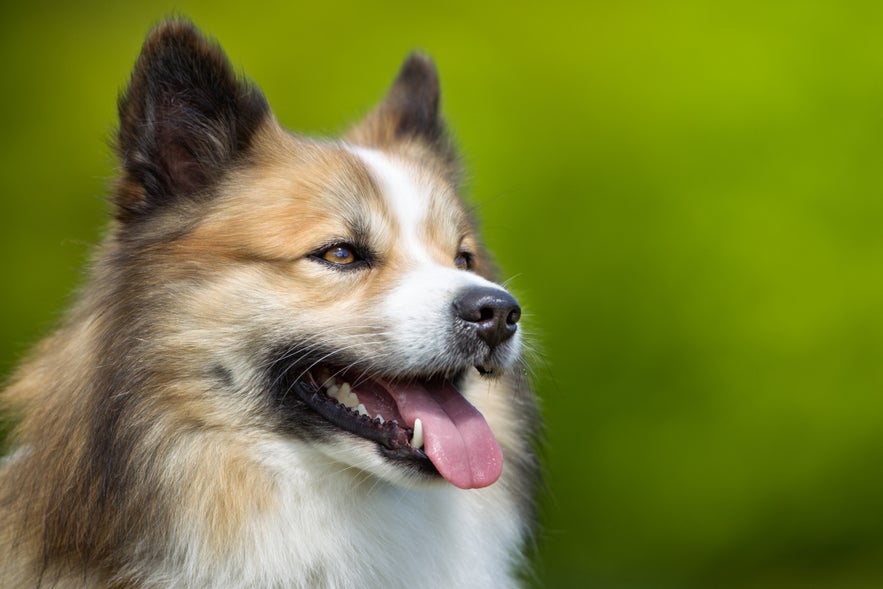
Just look at that happy little face. Isn't it cute? Meet the Icelandic Sheepdog, Iceland's only native dog breed. These fascinating dogs are an indispensable part of Icelandic culture, whether they're herding sheep or trekking through the wilderness alongside their owners on a Sunday hike.
Treasured for its friendly, affectionate nature, intelligence, and adorable appearance, the Icelandic Sheepdog has become a sought-after breed in the international dog community. In Iceland, the breed has become an integral part of many households, from rural farms in the Eastfjords to the capital of Reykjavik. If you decide to explore Iceland on one of many fantastic self-drive tours or rent a car by yourself, expect to run into these fluffy fellows on your travels around the Ring Road. It's also a good idea to book hotels in Iceland ahead of time, to make sure you have your spot secured.
In this article, we'll go over everything you need to know about the Icelandic Sheepdog. Where does it originate from? Why is the Icelandic Sheepdog so well suited to Iceland's harsh landscape? What are some of the breed's defining characteristics? Let's find out!
The History of the Icelandic Sheepdog
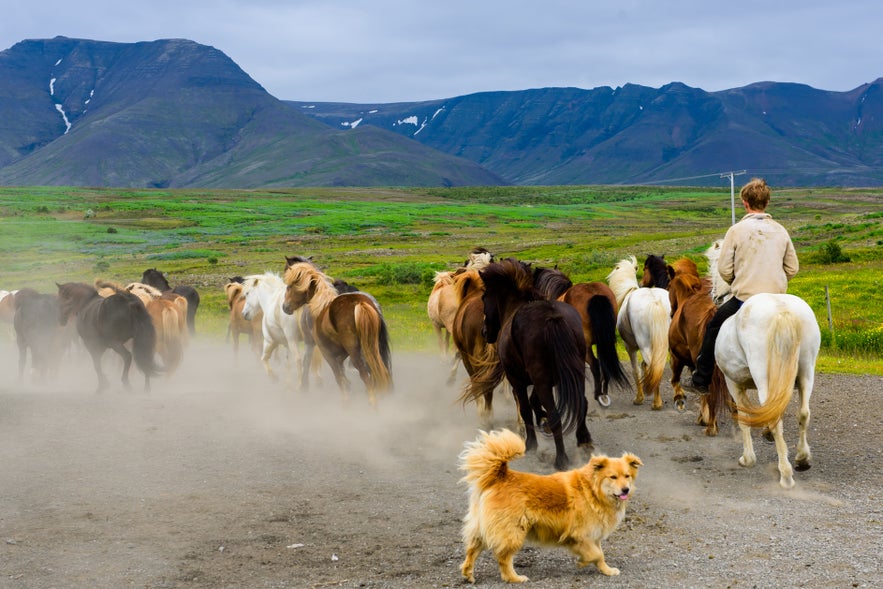 The Icelandic Sheepdog is an old breed, originally brought to Iceland by the Vikings when the country was settled around 874 AD. The breed is descended from dogs the Norse people found in Scandinavia and bears a resemblance to the Norwegian Buhund and the Shetland Sheepdog. According to research, the Icelandic Sheepdog is related to the Karelian Bear Dog, a Finnish Breed.
The Icelandic Sheepdog is an old breed, originally brought to Iceland by the Vikings when the country was settled around 874 AD. The breed is descended from dogs the Norse people found in Scandinavia and bears a resemblance to the Norwegian Buhund and the Shetland Sheepdog. According to research, the Icelandic Sheepdog is related to the Karelian Bear Dog, a Finnish Breed.
The breed's isolation on the remote island of Iceland contributed to its distinct characteristics and its ability to adapt to the harsh Icelandic climate. Over time, the Icelandic Sheepdog developed into a hardy and resilient breed with exceptional herding instincts, which were essential for the survival of farmers. As the name implies, the Icelandic Sheepdog was used for herding and protecting livestock, particularly sheep.
- See also: A Complete History of Iceland
However, the breed faced a decline in numbers during the 19th and 20th centuries due to various factors, such as canine diseases. By the mid-20th century, the Icelandic Sheepdog was on the brink of extinction. Fortunately, a group of dedicated individuals recognized the breed's value and initiated efforts to revive and preserve it. In 1969, the Icelandic Dog Breeder Association was formed with the goal of protecting and promoting the Icelandic Sheepdog.
Today, the Icelandic Sheepdog is still a rare breed but has gained recognition and popularity outside of Iceland.
Characteristics of the Icelandic Sheepdog

"At Besserstad I was presented with my Icelandic dog Kari. He was pure white, with the exception of his black cheeks and nose and pricked black ears, which stood up like two sharp points of rock out of a snow-drift. Indeed in snow he became almost invisible. A sweeter nature than Kari never ran upon four legs: nothing would make him bite or fight; he was friends with the whole world—except, indeed, pigs and donkeys."
Elizabeth Jane Oswald, By Fell and Fjord; or, Scenes and Studies in Iceland, 1882.
The Icelandic Sheepdog is a spitz-type breed of medium size, typically weighing between 20 to 35 pounds. It has a strong build with a thick double coat which does well to protect it from the elements in Iceland. As is typical of the spitz family of breeds, it has a curled tail and pointy ears.
 Known to be incredibly friendly, the Icelandic Sheepdog is both energetic and playful. They are a very vocal breed and are known to bark at unfamiliar things, which makes them good watchdogs. The Icelandic Sheepdog is both intelligent and eager to please, which makes them relatively easy to train. However, they can sometimes be stubborn, and their herding instinct can be a challenge.
Known to be incredibly friendly, the Icelandic Sheepdog is both energetic and playful. They are a very vocal breed and are known to bark at unfamiliar things, which makes them good watchdogs. The Icelandic Sheepdog is both intelligent and eager to please, which makes them relatively easy to train. However, they can sometimes be stubborn, and their herding instinct can be a challenge.
Icelandic Sheepdogs are also very active and require regular exercise. This makes daily walks and play sessions an absolute must and is a big reason why they're so popular in the countryside, where they have more freedom than within the confines of the city. Typically, Icelandic Sheepdogs live for about 12-15 years.
The Icelandic Sheepdog in Popular Culture
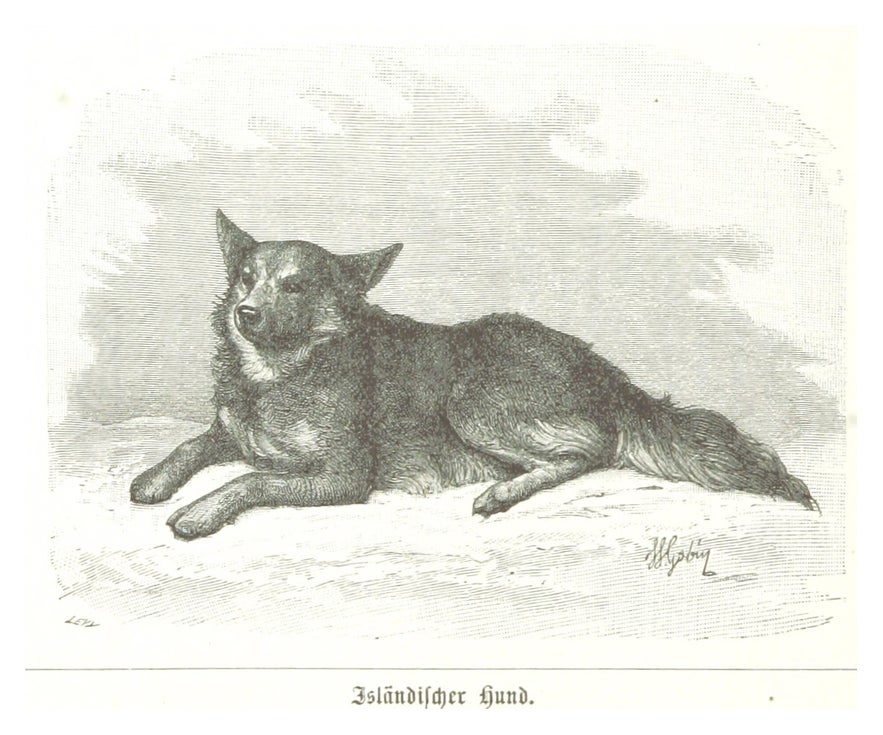 Although the Icelandic people of old had many detailed writers, it seems like they weren't overly interested in describing the Icelandic sheepdog. No descriptions of dogs are found in the Icelandic sagas, although some notable dogs are mentioned, such as Samur, who belonged to the hero Gunnar from Hlidarendi. Samur, however, is believed to have been an Irish Wolfhound.
Although the Icelandic people of old had many detailed writers, it seems like they weren't overly interested in describing the Icelandic sheepdog. No descriptions of dogs are found in the Icelandic sagas, although some notable dogs are mentioned, such as Samur, who belonged to the hero Gunnar from Hlidarendi. Samur, however, is believed to have been an Irish Wolfhound.
The international renown of the Icelandic Sheepdog is not a recent thing, as the Swedish clergyman Olaus Magnus wrote in 1555 that the dogs were popular with upper-class people. In 1570, humanist John Caius said that the dogs were a favorite among British aristocrats.
The Icelandic Sheepdog seems to have even garnered the attention of the legendary playwright William Shakespeare, who mentions the breed briefly in the play Henry V:
"Pish for thee, Iceland Dog! Thou prick-ear’d cur of Iceland."
Shakespeare doesn't seem to have particularly fond of the Icelandic Sheepdog, but then he's been noted to have not been too fond of dogs in general. He was probably more of a cat person.
The Icelandic Sheepdog features in multiple travel chronicles about Iceland throughout the centuries, where it is described as a diligent and faithful member of a household. One chronicle describes three types of dogs, the other two being miniature hunting dogs with a short coat and tail. This hunting breed is believed to have gone extinct in the 18th century.
In modern culture, no Icelandic Sheepdog has reached Lassie levels of fame, but they are prominent in Icelandic children's literature and movies.
Rettir - The Icelandic Sheepdog's Superbowl
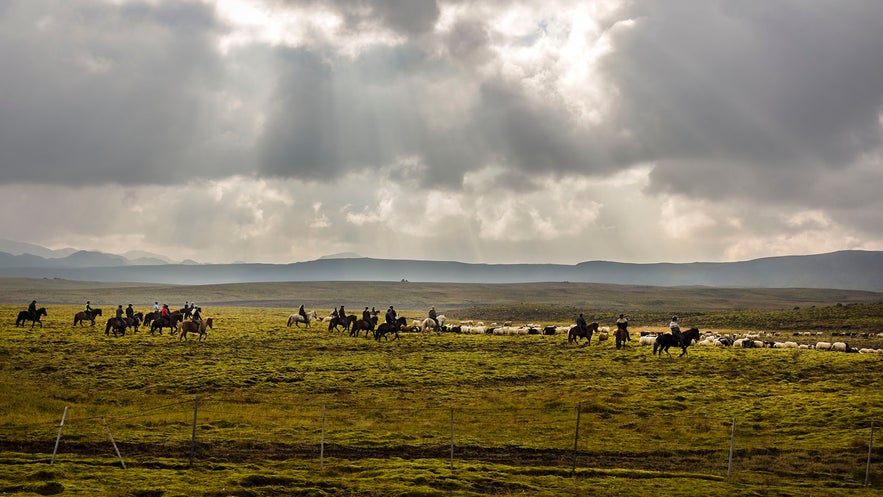
Image from Wikimedia, Creative Commons, by Hafsteinn Robertsson.
September is a time of great anticipation for the Icelandic Sheepdog as that's when the annual roundup of Iceland's sheep, or "rettir," takes place. With an estimated half a million sheep in Iceland, a number significantly higher than the human population, there's plenty of work to be done. Rettir is a huge event, and many people travel from the city to the countryside to take part.
Icelandic sheep roam freely during the summer months and are known to venture into the highlands to graze on wild herbs and grass. This free-range grazing is essential for the quality of Icelandic lamb meat, which is known for its distinctive, gamey taste. During rettir, farmers go on horseback or foot to look for the sheep and wrangle them back to the farms with help from the sheepdogs.
When the sheep get back, they are herded into sorting pens, where they are separated into stalls by markings on their ears to differentiate between the farms they belong to. After the roundup is finished, there are often celebrations with plenty of food, drink, and music. As you might expect, the Icelandic Sheepdog is in its element during rettir, as it can really showcase its herding skills.
Owning an Icelandic Sheepdog

Image from Wikimedia, Creative Commons, by Helgi Halldórsson.
If you're interested in obtaining an Icelandic Sheepdog, you should begin by visiting the website of the national breed club or association in your country. These organizations typically maintain a list of reputable breeders and can provide guidance on what to expect when purchasing or adopting an Icelandic Sheepdog.
Take your time to research and make sure you're getting a dog from a responsible source. Avoid impulse buying from pet stores or unresearched online sellers, as they may be associated with puppy mills. Ask breeders about health clearances, meet the puppy's parents (or at least the mother), and visit the place where the puppies are raised.
Regardless of where you obtain your Icelandic Sheepdog, remember that bringing a dog into your home is a long-term commitment. The Icelandic Sheepdog is energetic and requires a lot of time outdoors, so ensure you're ready for the responsibility in terms of time, finances, and care.
If you're not looking to own an Icelandic Sheepdog but still want to see one, you should check out Reykjavik Family Park & Zoo. There you can meet Icelandic Sheepdogs in person and get to know other animals typically found in Icelandic farms.
Dog Sledding in Iceland
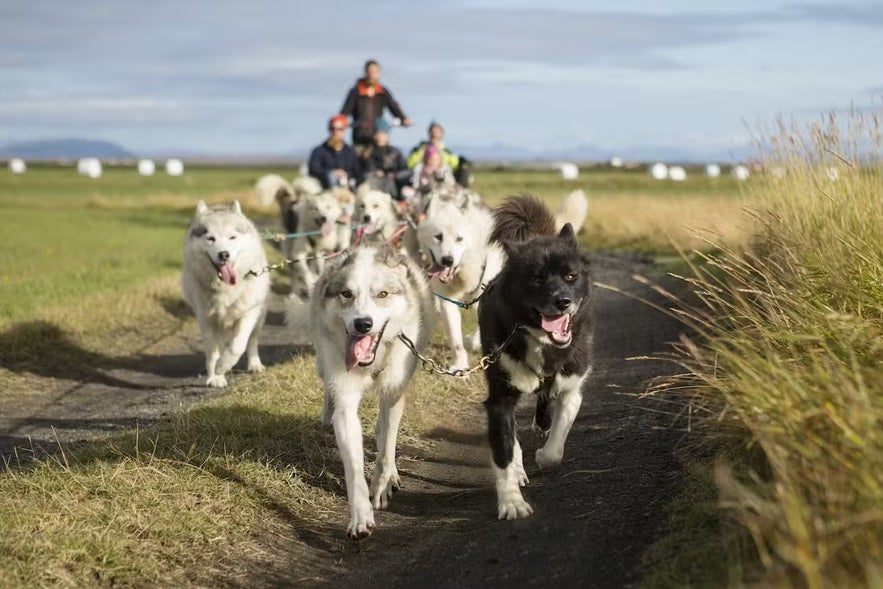 While Iceland might be more famous for its horseback rides, dog sledding has recently grown in popularity as a recreational activity for locals and as an attraction for visitors during the winter months. Although it does not have deep roots in Icelandic history, it does take inspiration from Iceland's close neighbors from Greenland.
While Iceland might be more famous for its horseback rides, dog sledding has recently grown in popularity as a recreational activity for locals and as an attraction for visitors during the winter months. Although it does not have deep roots in Icelandic history, it does take inspiration from Iceland's close neighbors from Greenland.
The Icelandic Sheepdog is not used in dog sledding, as its build is unsuited for such an activity. The most commonly used dogs for sledding in Icelandic are thus Siberian Huskies and Greenlandic Dogs, which are well adapted to cold climates and have the stamina and strength required for pulling sleds.
Witnessing the Icelandic landscape from the back of a dog sled is a great adventure that can be experienced on this 3-hour dog sled tour with transfer from Reykjavik. If you plan on visiting Iceland during the winter months, don't miss out on this unique experience.
Ideas for Icelandic Dog Names
If you're looking for a name for your Icelandic Sheepdog or any other breed, here are some popular names that people in Iceland like to give their dogs:
Masculine dog names:
Snati (inquisitive)
Vaskur (brave)
Sámur (dark-colored)
Kolur (coal)
Hvatur (quick)
Feminine dog names:
Píla (dart, arrow)
Perla (pearl)
Birta (brightness)
Esja (mountain)
Fluga (fly)
That about covers it for the Icelandic Sheepdog. Do you have questions we didn't answer? Do you have any experience in owning or meeting an Icelandic Sheepdog? Let us know in the comments below!
関連記事
ロマンチック・アイスランド
アイスランドの迫力のある大自然は、時にとっても美しくロマンチック。都会の喧騒を忘れて、大切な人と過ごす時間。地平線に沈みゆく夕日を見たり、絶え間なく流れる滝の音に耳を傾けながら、アイスランドを旅するのもロマンチックなひとときです。 各種セルフドライブツアーの比較・検索はこちらから オプションも追加可能!夏のパッケージツアー7日間 滞在期間が短い方にオススメ!冬のパッケージツアー4...もっと読む
2023年のリトリ・フルトゥル山噴火のすべて
2023年にアイスランドで噴火したリトリ・フルトゥール山のすべてをご紹介します!噴火の規模は?今訪れて大丈夫なの?火山を見学するおすすめの方法は?噴火は危険?噴火はいつ終わったの?などなど、アイスランドで噴火したばかりの火山に関する疑問・質問にお答えします! 7月10日の午後5時少し前、レイキャネス半島のリトリ・フルトゥル山(Litli-Hrutur)が噴火しました。数日前から地震が続いていたの...もっと読む冬のアイスランドのおすすめアクティビティ
アイスランドの冬っていつ?冬のアイスランド旅行では何が楽しめる?おすすめのアクティビティは?一番人気のアイスランド冬季ツアーは?冬のアイスランド旅行の楽しみ方を全て教えます! アイスランドの冬といえばオーロラが有名です。とんでもなく寒いんでしょ?とよく言われるのですが、実は冬のアイスランドは緯度の割には寒くありません。メキシコ湾から流れてくる暖流が温かい空気を運んでくるからです。 レイキ...もっと読む

アイスランド最大の旅行アプリをスマートフォンにダウンロード。旅のすべてを1か所で管理できます。
アイスランド最大の旅行マーケットプレイスをポケットに。スマートフォンのカメラでQRコードを読み取り、表示されるリンクをクリックしてください。電話番号またはメールアドレスを入力すれば、SMSやEメールでもダウンロードリンクを受け取ることができます。




















